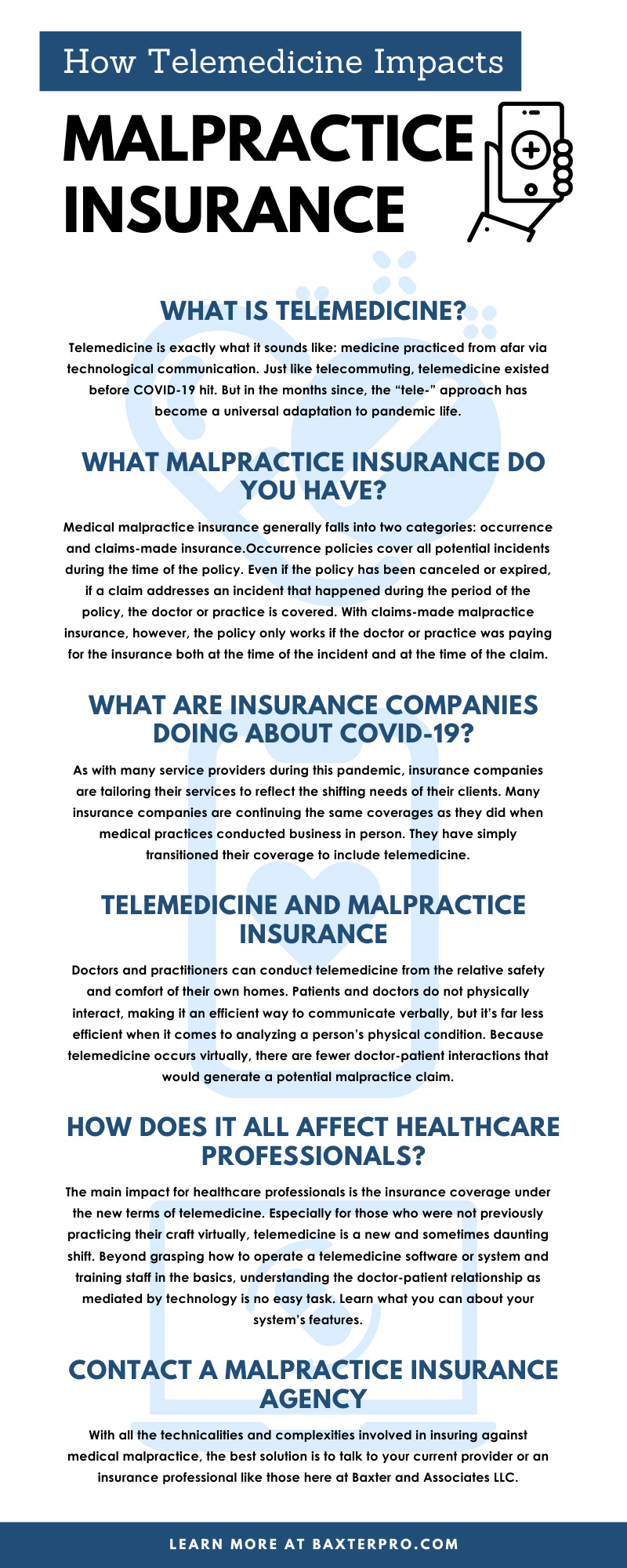With the coronavirus disease 2019 (or COVID-19) impacting every aspect of life, from work to school, getting groceries to attending sports games, there are few things it hasn’t touched in this new normal. For those still operating their businesses, decisions are necessary regarding physical office space, marketing campaigns, and staff size. But one area business operators may have not considered is the impact of COVID-19 on their insurance. Particularly, many medical professionals may be wondering how telemedicine impacts malpractice insurance.
What Is Telemedicine?
Telemedicine is exactly what it sounds like: medicine practiced from afar via technological communication. Just like telecommuting, telemedicine existed before COVID-19 hit. But in the months since, the “tele-” approach has become a universal adaptation to pandemic life. Telemedicine usually takes place via video chats, allowing the doctor and patient to have face-to-face interaction through a digital screen. The patient can describe their symptoms and experiences to the doctor remotely, and the doctor can discuss courses of action with them. Prescriptions, referrals, and follow-up appointments can all happen electronically, so the entire process is possible with the appropriate pandemic distancing. However, because of this change in medical care, questions have arisen regarding the legal and insurance side of the equation.
What Malpractice Insurance Do You Have?
Medical malpractice insurance policies can vary significantly, depending on the specialization of the doctors, the amount of desired coverage, and the location of the practice. Professional liability malpractice insurance is one of the requirements to practice in many states across the U.S. Despite these often-customized insurance policies, medical malpractice insurance generally falls into two categories: occurrence and claims-made insurance.
Occurrence policies cover all potential incidents during the time of the policy. Even if the policy has been canceled or expired, if a claim addresses an incident that happened during the period of the policy, the doctor or practice is covered. With claims-made malpractice insurance, however, the policy only works if the doctor or practice was paying for the insurance both at the time of the incident and at the time of the claim. Each has its own benefits and drawbacks, but regardless of the malpractice insurance you have, it is best to fully understand it and how COVID-19 affects your coverage.
What Are Insurance Companies Doing About COVID-19?
As with many service providers during this pandemic, insurance companies are tailoring their services to reflect the shifting needs of their clients. Many insurance companies are continuing the same coverages as they did when medical practices conducted business in person. They have simply transitioned their coverage to include telemedicine. However, due to the opportunity for telemedicine to cross state lines, medical practitioners must be aware of their patients’ locations. If a medical professional is only licensed to practice in a particular state, but their patient is not receiving care in that state, then there may be issues that arise. Be wary, though, because some insurance providers have not made this transition and are not planning to include telemedicine in their coverage.
Telemedicine and Malpractice Insurance
Doctors and practitioners can conduct telemedicine from the relative safety and comfort of their own homes. Patients and doctors do not physically interact, making it an efficient way to communicate verbally, but it’s far less efficient when it comes to analyzing a person’s physical condition. Because telemedicine occurs virtually, there are fewer doctor-patient interactions that would generate a potential malpractice claim. There are no complex procedures taking place and no physical contact with the patient, so there is less risk. Telemedicine is also most effective for normal checkups and writing prescriptions. Overall, telemedicine features lower liability because there is less opportunity for malpractice to occur.
How Does It All Affect Healthcare Professionals?
The main impact for healthcare professionals is the insurance coverage under the new terms of telemedicine. Especially for those who were not previously practicing their craft virtually, telemedicine is a new and sometimes daunting shift. Beyond grasping how to operate a telemedicine software or system and training staff in the basics, understanding the doctor-patient relationship as mediated by technology is no easy task. Learn what you can about your system’s features. Also, seek guidance from fellow healthcare professionals during this time, particularly those who had already been using telemedicine to conduct their business for some time.
One new thing to consider with telemedicine is the issue of security. If not handled properly and securely, patient records or telemedicine sessions can become compromised, and opening up sensitive information to theft by malicious parties. Conduct more research into the safety features of your telemedicine software. Make sure that you have a secure log-in for both the doctor and the patient. Also, find safe ways to archive and store any videos or photos you take during telemedicine sessions. Be sure to provide information to patients about HIPAA so that they understand their rights. The world of technology can be helpful, but it can also be dangerous. See to it that you and your staff receive comprehensive training on how to handle confidential information electronically.
Contact a Malpractice Insurance Agency
With all the technicalities and complexities involved in insuring against medical malpractice, the best solution is to talk to your current provider or an insurance professional like those here at Baxter and Associates LLC. There is no better solution than speaking directly with those in charge of your insurance because they will be able to give you the most accurate and up-to-date information regarding your policy. You may need to be ready to restructure your policy or switch providers based on your changing needs. Also, if your policy is ending soon, make sure that any renewals include telemedicine coverage.
The changes necessary to respond to COVID-19 are far and wide. Understanding how telemedicine impacts malpractice insurance is one way to transition and adapt well to the new way of life. Medical professionals seek to serve, help, and heal. It is important to make sure your practice has the protection it needs in every capacity so that people can continue to receive the medical attention they need.








